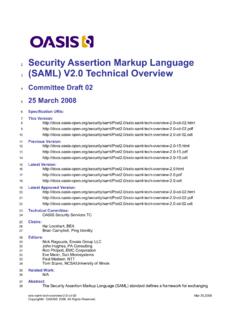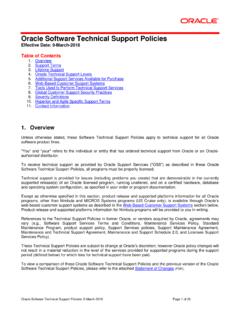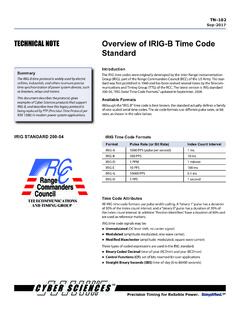Transcription of Serial Control Interface Standard (Rev 1.0) - Analog Devices
1 ADI-SPIT echnical SpecificationSerial Control Interface Standard (Rev ) ADI-SPI2 Rev Keywords SPI, SIF, Interface ADI-SPI3 Rev Contents 1 Scope .. 5 Compliance .. 5 2 References .. 5 3 Definitions, symbols and abbreviations .. 5 Definitions .. 5 Abbreviations .. 6 4 Physical Layer .. 6 General .. 6 Pins .. 6 CSB .. 6 SCLK .. 6 SDIO .. 6 SDO .. 6 Voltages and Interface standards .. 7 Reference Configuration .. 7 Minimum configuration .. 7 Three wire bus .. 7 Four wire bus .. 8 Mixed bus .. 8 5 Data Link .. 8 General .. 8 Protocol .. 9 Instruction .. 9 Read/Write .. 9 Address .. 9 9 Single Byte 9 Streaming Bytes .. 10 Timing .. 10 Write Cycle .. 11 Read Cycle .. 11 Clock Domains .. 11 Write Strobe Synchronization .. 11 Read Strobe Synchronization .. 12 6 Control .
2 12 General .. 12 Interface Configuration Register A 0x0000 .. 12 Soft Reset .. 12 LSB 12 Address Ascension .. 12 SDO Active .. 13 Register 0x0000 Details .. 13 Interface Configuration Register B 0x0001 .. 13 Single Instruction .. 13 Bit 6 .. 13 Master Slave Readback Control .. 13 Slow Interface Control .. 13 Bit 3 .. 14 Soft Reset 1 .. 14 Soft Reset 0 .. 14 Register 0x0001 Details .. 15 Device Configuration Register 0x0002 .. 15 Operating Mode .. 15 Custom Operating Mode .. 16 Device Status .. 16 ADI-SPI4 Rev Chip Type 0x0003 .. 16 Product ID 0x0004 & 0x0005 .. 16 Chip Grade 0x0006 .. 16 Reserved 0x0007 .. 16 Offset Pointer/Device Index 0x0008 .. 16 Device Index 0x0009 .. 17 Scratch Pad 0x000A .. 17 SPI Revision 0x000B .. 17 Vendor ID 0x000C & 0x000D .. 17 Reserved 0x000E.
3 17 Transfer Register .. 17 Master-Slave Transfer Bit .. 17 Product Specific Memory .. 18 Power up delay .. 18 7 Memory Map .. 19 8 Example Timing Diagrams .. 20 3-Wire Figures .. 20 4-Wire Figure .. 20 MSB First Figures .. 20 LSB First Figures .. 20 Address Descension Figures .. 20 Address Ascension Figures .. 20 Write Operation .. 20 Read Operation .. 21 Timing Diagrams .. 21 9 Application .. 22 General .. 22 Reserved .. 22 Master-Slave Latching .. 22 Software Synchronization .. 22 Pin Synchronization .. 22 CSB Deactivation .. 23 Delayed Synchronization .. 23 Pin & Function Re-Definitions .. 23 Conversion of SPI pins to Pin Mode Control by bus sequencing .. 23 Other options for conversion .. 24 Alternate Mapping .. 24 Hard Reset/Soft Reset .. 24 Device Discovery .. 24 Optional SDO .. 24 Broadcasting.
4 24 Blind Start-Up Operation and Regaining Interface Control .. 24 Operation with mixed logic family Devices .. 24 Reserved .. 25 Reserved .. 25 Reserved .. 25 Reserved .. 25 Reserved .. 25 Reserved .. 25 Single Device Applications .. 25 Working with byte wide data .. 25 Working slow microcontrollers .. 26 ADI-SPI5 Rev 1 Scope The purpose of this document is to define the physical specification that enables Serial Interface compatibility across ADI products for the primary purpose of device Control and monitoring. The Interface defined herein is generically defined as a SPI port and consists of chip or device select, clock, bi-directional data with an optional data out. This document also includes definition of frame structure to ensure consistency across products as well as a uniform map structure to simplify and standardize driver development for products conforming to this specification.
5 The specification is written with sufficient flexibility to allow interfacing to a wide range of controllers including FPGA, DSP, uC, RISC as well as SPI emulation with bit-banging when necessary. Compliance All products that implement this Interface should reference this protocol (ADI-SPI). In addition, those products should also clearly state their support for optional functionality listed in the table below. Feature Description Section 3 wire or 4 wire The minimum Interface consists of SCLK, CSB and SDIO. The 4th wire, SDO, is optional. introduces the optional 4th wire (SDO) Master-Slave Transfer The minimum consists of core registers without buffering. Master-slave transfer registers are optional. 2 References JESD8-23 Unified Wide Power Supply Voltage Range CMOS DC Interface Standard for Non-Terminated Digital Integrated Circuits +/- (Nominal Range) and (Wide Range) Power Supply Voltage and Interface Standard for Nonterminated Digital Integrated Circuits JESD8-7A +/- (Nominal Range) and (Wide Range)
6 Power Supply Voltage and Interface Standard for Nonterminated Digital Integrated Circuits Linux USB Project, 3 Definitions, symbols and abbreviations Definitions Data state of the SDIO or SDO pin Streaming is the process by which multiple bytes of data are written to or read from the slave device without specifically providing instructions for each byte and is implemented by continually holding the CSB active and continuing to shift new data in or old data out of the slave device. Master Slave Latch A two stage memory where data is latched into the first stage based on one clock and then to the second stage with a different clock and is often used to ensure synchronization across clock domains. In this application, some registers may employ this technique to ensure special timing relationships are maintained. Those registers that utilize master slave latches will be clearly noted in the product datasheet.
7 ADI-SPI6 Rev Abbreviations CSB Chip Select Bar SCLK Serial Clock SDIO Serial Data Input/Output SDO Serial Output 4 Physical Layer General Pins The defined Serial Interface shall consist of SCLK, SDIO, CSB and SDO. CSB CSB is the chip select, an active low signal that selects the slave device with which the master intends to communicate. Typically, there is a dedicated CSB between the master and each slave. CSB is always driven by the master. CSB also functions to synchronize and frame the communications to and from the slave device. When CSB is de-asserted and returned high, the controller completes the current access and returns the controller to the ready state awaiting the next instruction.
8 De-asserting CSB in the middle of a transaction aborts part or all of that transfer. If the transaction is aborted before the instruction is complete, no action is taken and the state machine returns to the ready state. If the transaction is aborted in the middle of the first data word, the transaction is aborted and the state machine returned to the ready state. If one or more complete data bytes have been completed after the instruction phase and before the abort occurs, those completed data bytes are written (or read), however any partial data bytes are aborted. See section Timing Diagrams for examples of abort possibilities. If CSB is de-asserted in the middle of a write to address 0x00 or 0x01, the soft reset bits (see section Soft Reset, Soft Reset 1 and Soft Reset 0) may or may not occur. It is assumed that if the CSB is de-asserted in the midst of configuring these registers a system failure has occurred and the slave device will receive subsequent configuration commands.
9 Otherwise, it is expected that slave operations would continue normally during this process. SCLK SCLK is the Serial clock signal that synchronizes the slave device(s) to the master. Typically, SCLK is shared for all slave Devices on the Serial bus. SCLK is always driven by the master. For both master and slave Devices , data will be valid before the rising edge of SCLK and meet the respective setup and hold times. SDIO SDIO is the bi-directional data signal. Typically, SDIO is shared for all slave Devices on the Serial bus. SDIO is a bidirectional high impedance pin on both master and slave. For compatibility, all Devices must include bi-directional support in 3-wire mode which is the power up default. If 4-wire mode support is available, the SDO pin may be included and enabled by the user as part of Interface configuration but the bi-directional capability of SDIO is still required, even if disabled during configuration.
10 If 4-wire is enabled by configuring SDO, SDIO functions only as an input (SDI) until SDO is disabled. SDO SDO is the optional slave data output pin. Typically, SDO is shared for all slave Devices on the Serial bus. SDO is driven by only one slave device at a time, otherwise high impedance. SDO is always in high impedance while the slave CSB is false; otherwise assertion is controlled through the data link protocol. The only exception to this is when SDO has been assigned an alternate function as defined in section Pin & Function Re-Definitions. ADI-SPI7 Rev Voltages and Interface standards In order to ensure as much compatibility as possible, Devices implementing this Standard will specify compliance to the most current version of one of the following standards : JESD8-23, JESD8-7A or The Standard specified will be dependent on the processing node and supply voltage required.






